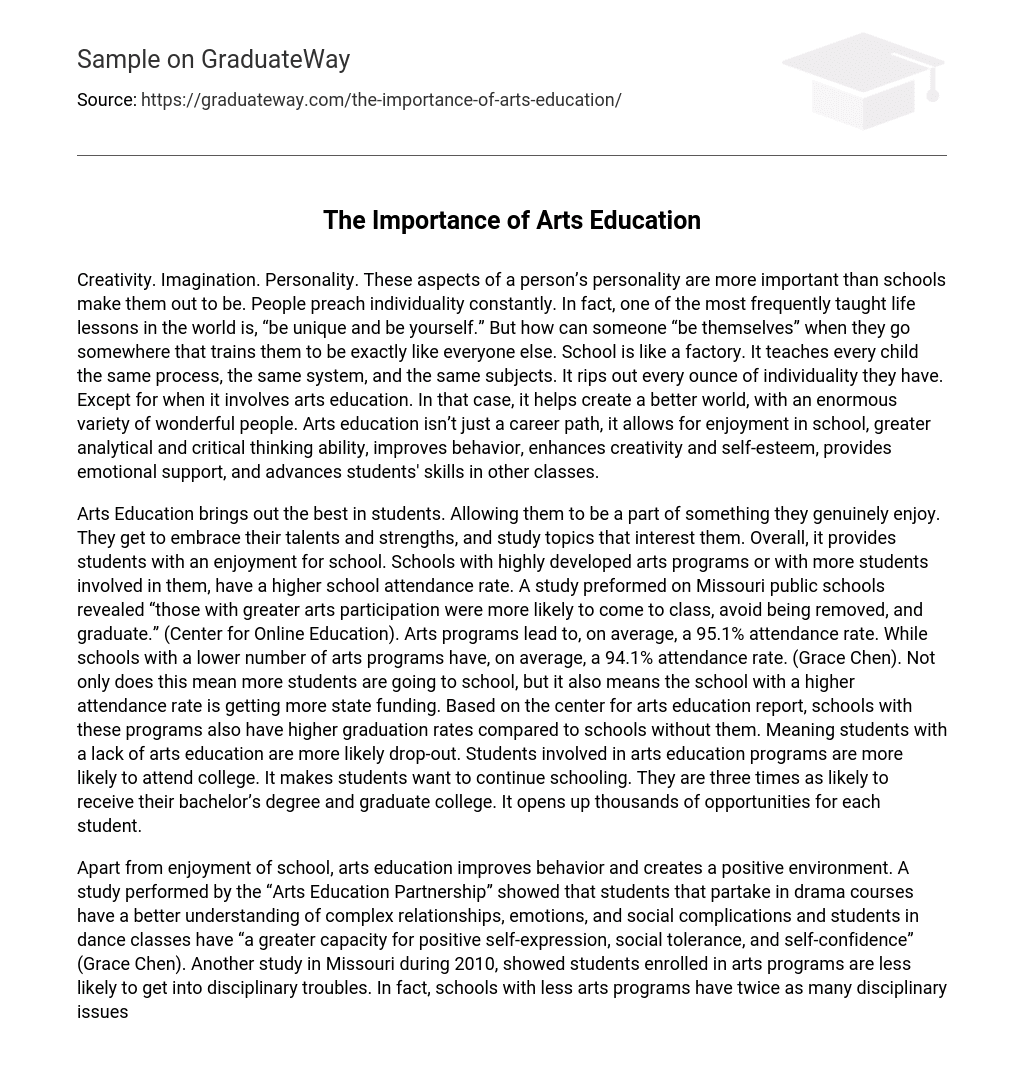Creativity. Imagination. Personality. These aspects of a person’s personality are more important than schools make them out to be. People preach individuality constantly. In fact, one of the most frequently taught life lessons in the world is, “be unique and be yourself.” But how can someone “be themselves” when they go somewhere that trains them to be exactly like everyone else. School is like a factory. It teaches every child the same process, the same system, and the same subjects. It rips out every ounce of individuality they have. Except for when it involves arts education. In that case, it helps create a better world, with an enormous variety of wonderful people. Arts education isn’t just a career path, it allows for enjoyment in school, greater analytical and critical thinking ability, improves behavior, enhances creativity and self-esteem, provides emotional support, and advances students’ skills in other classes.
Arts Education brings out the best in students. Allowing them to be a part of something they genuinely enjoy. They get to embrace their talents and strengths, and study topics that interest them. Overall, it provides students with an enjoyment for school. Schools with highly developed arts programs or with more students involved in them, have a higher school attendance rate. A study preformed on Missouri public schools revealed “those with greater arts participation were more likely to come to class, avoid being removed, and graduate.” (Center for Online Education). Arts programs lead to, on average, a 95.1% attendance rate. While schools with a lower number of arts programs have, on average, a 94.1% attendance rate. (Grace Chen). Not only does this mean more students are going to school, but it also means the school with a higher attendance rate is getting more state funding. Based on the center for arts education report, schools with these programs also have higher graduation rates compared to schools without them. Meaning students with a lack of arts education are more likely drop-out. Students involved in arts education programs are more likely to attend college. It makes students want to continue schooling. They are three times as likely to receive their bachelor’s degree and graduate college. It opens up thousands of opportunities for each student.
Apart from enjoyment of school, arts education improves behavior and creates a positive environment. A study performed by the “Arts Education Partnership” showed that students that partake in drama courses have a better understanding of complex relationships, emotions, and social complications and students in dance classes have “a greater capacity for positive self-expression, social tolerance, and self-confidence” (Grace Chen). Another study in Missouri during 2010, showed students enrolled in arts programs are less likely to get into disciplinary troubles. In fact, schools with less arts programs have twice as many disciplinary issues. They have a higher suspension rate and behavioral outbursts (Grace Chen). Based on “Liberty Classical Academy,” “Learning a musical instrument, creating a painting, learning to dance, or singing in a chorus teaches that taking small steps, practicing to improve, being persistent, and being patient are important for children’s growth and improvement.” A study by John Hopkins showed “that sustained arts education is an essential part of social and intellectual development.” (Center for Online Education).
Arts education doesn’t just improve students behaviorally and positivity, it improves their analytical and critical thinking abilities. According to “Liberty Classical Academy,” “through arts children learn to observe, interpret, see different perspectives, analyze, and synthesize.” Students become more attentive and focus on details. Critical thinking skills are important in not only school and college, but in any life problem. Eliot Eisner once said, “learning through the arts promotes the idea that there is more than one solution to a problem, or more than one answer to a question.” (Robing Pogrebin). Showing that arts programs give students the power to see different resolutions. For example, in art if a child accidently leaves a pencil mark on their project they could turn it into a bird or a tree. It may sound simple, but this type of thinking is incredibly complicated and useful.





